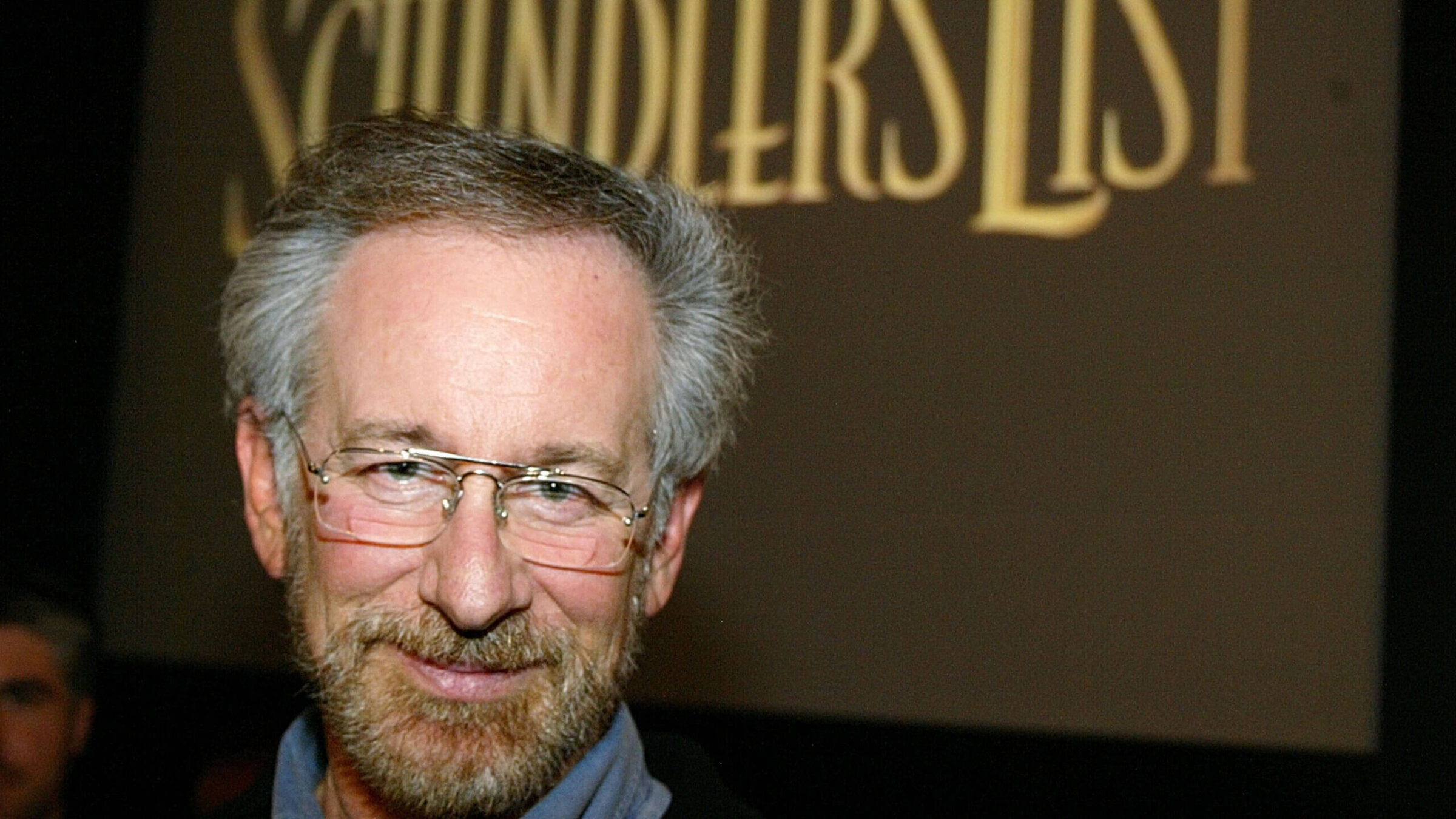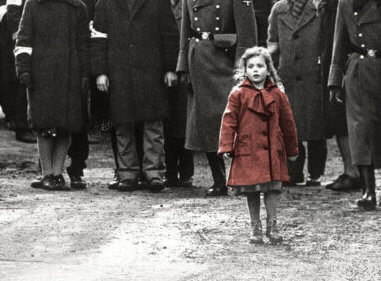‘Schindler’s List’ is darker — and braver — than you may remember
The film, Schindler’s List, marking its 30th anniversary, has been unjustly dismissed by scholars

Spielberg’s film Schindler’s List left many scholars unsatisfied — but it’s a more complex film than its most melodramatic moments. Photo by Carlo Allegri/Getty Images
When people remember Schindler’s List, they may best recall its last, morally uncomplicated moments.
Before he leaves his factory in Brünnlitz, Liam Neeson’s Oskar Schindler addresses the 1,000 or so Jews he saved. Crossing himself, he requests three minutes of silence for the Jewish dead, but the rabbi present instead says the Kaddish. On Schindler’s way into exile — the war is over, and he will be hunted as a member of the Nazi party and a profiteer of slave labor — the floodgates open. Over the strains of Yitzhak Perlman’s violin, Schindler sees his material possessions and breaks down. He could have traded his car for the lives of Jews — 10, easy. His swastika pin, made of gold, was worth two more Jews.
“I didn’t do enough,” he cries. (The song on the soundtrack is titled “I Could Have Done More.”)
In evaluating Schindler’s List, which marks is 30th anniversary on Dec. 15, some have leveled the same critique at Steven Spielberg. The director, who won an Oscar for the 1993 film, could have done more, or done something altogether different, for his film about the Holocaust.
Stanley Kubrick reportedly quipped that it wasn’t a film about the genocide at all, remarking “the Holocaust is about 6 million people who get killed. Schindler’s List was about 600 people who don’t.” Art Spiegelman called its Jewish characters “slightly gentrified versions” of Der Sturmer caricatures. Academics took Spielberg to task for dramatizing the life of a righteous gentile, stealing focus from Jewish suffering or making it merely instructive for a Christian’s redemptive journey. The optics, even in 1993, were bad.
But rewatching the film, I was shocked by what I didn’t remember — and what Spielberg wasn’t afraid to show.
If you remember only one thing from the film, it is almost certainly the Girl in the Red Coat, who Schindler glimpses while he rides on horseback during the liquidation of the Krakow ghetto, and later in a pile of dead bodies. But seconds before that image, literally highlighted on otherwise black-and-white film, we see another Jewish child, Adam, a volunteer for the ghetto police.
Adam blows his whistle to alert his Nazi handlers to a Jewish woman, but when he realizes he knows her, he hides her under a set of stairs. If the innocence of the Girl in Red is maudlin, Adam’s lost innocence is gutting. Mrs. Dressner, whom Adam places in “the good line” along with her daughter, Danka, tells him “you are not a boy anymore.” (Film historian Annette Insdorf mentioned this scene as one that appeared to “expand the notion of heroism,” but it also hints at a darkness in the others Adam no doubt informed on.)
The depiction of Jewish collaboration was not lost on some of the film’s early critics, who blasted Spielberg for including it, and, what’s more, for placing certain scheming Jews in a church. But while characters like Marcel Goldberg, who we see volunteering for the ghetto police, and later as a venal Kapo in Płaszów, are unflattering, portraying these Jewish middle managers is essential to breaking away from a simplistic paradigm of helpless victim and all powerful oppressor. The infamous charge of “kitsch” from Nobel Laureate and survivor Imre Kertész is only part of the film’s sensibility. While no one would accuse its presentation of nuance, not infrequently its verdict on human nature is realistic if not downright cynical.
Poldek Pfefferberg, the Schindler Jew who pushed Thomas Kenneally to write his novel Schindler’s Ark, is seen in the film trading on the black market and surviving through his wits. He is as much a part of the ghetto ecosystem as the stoic Hasidic men whose peyot were cut by gleeful Germans. The Jews who served the Judenrat are likewise a part of history, and not one many non-Jews know. As surprised as I was to encounter these complicated Jews years after my last viewing of the film, I was heartened to see that the Christian savior story was more variegated than I recalled, giving Jews a high level of agency. They are not merely props in a morality play.

You may not remember these brief sequences in Schindler’s List: A Jewish doctor doles out poison to his patients as the Gestapo advance; a family swallows jewels encased in bread; a father grabs a Nazi gun as his son runs from a roundup. The scenes may carry the aura of cliche for those of us reared on these stories of resistance, but one need only consider the global audience Spielberg made the film for, and the regularly repeated canard that Jews all went docilely to their deaths, to understand their importance. These moments are quick and soon forgotten, but for the first hour of the film the plot not only lingers on Jews, but features an active and brave Jewish protagonist in Itzhak Stern, played by Ben Kingsley.
It’s Stern who maneuvers through Nazi bureaucracy to give fellow Jews a chance at wellbeing in the ghetto — including a man with one arm he recruits to be a machinist in Schindler’s enamelware factory. This happens while Schindler has affairs and luxuriates in the seized home of a wealthy Jewish couple. In order to call Schindler’s trajectory Christlike, as many do, Jesus would have had to first be a remarkable sinner, and one whose proxy act of salvation was woefully incomplete.
Stern’s heroism, which continues in the camp, may seem mitigated for some — like Spiegelman, who called him a “juiceless Jewish accountant” — by his stereotypically Jewish vocation, but this is a case of protesting too much, especially given his role in Schindler’s pivot to humanity.
At its root, Schindler’s List, which laces a momentous narrative with jokes from the ghetto and cattle car discussions of cholent ingredients, is a story about the power of testimony, anticipating Spielberg’s creation of the USC Shoah Foundation.
Tablet’s Liel Liebowitz said that Schindler’s witnessing the Girl in the Red Coat sparks in him “a nearly instantaneous epiphany, realizing that life is precious and that Jews should be saved.” But such criticisms neglect or forget the subtler, and more central steps on the way to his awakening.
What first turns Schindler away from his own self interest is not seeing the girl — either dead or alive — but Stern telling him how Ralph Fiennes’ monstrous Amon Goeth recently went through a crowd of 50 Jews, killing every other man with a pistol.
Schindler then goes to Goeth’s maid, Helen Hirsch (Embeth Davidtz), who tells him how the commandant shot a woman carrying a bundle, for no reason whatsoever. Given her position and Schindler’s, such candor is not without its risks. (That Spiegelman appeared to dub Hirsch, a hostage of Goeth’s, a stock “Jewish seductress” is beyond offensive.)
To expect more from the film’s Jews — who include the architect Diana Reiter, shot for daring to mention a faulty foundation in a camp building’s construction, and a woman who conducts a clandestine Jewish wedding in the concentration camp barracks — is to want a different story entirely. Certainly that is understandable and even this history as presented is somewhat simplified, but one can’t forget that Spielberg was making a film for a mass audience, which really means gentiles. A story rooted purely in a Jewish perspective would have its work cut out for it, and the film is not without a Jewish lens, even going up to the showers — if not gas chambers — at Auschwitz in point of view shots.
Forsaking the German viewpoint would also forfeit something necessary: the intimation that the viewers could themselves have been complicit, a suggestion that Jonathan Glazer fully commits to in his new film The Zone of Interest, which plays out almost entirely among a Nazi family. It is true that Spielberg’s structure risks letting an audience off easy, allowing them to believe they would act as Schindler did, but when weighing the film’s educational value, a less defensive viewership may be a good thing. It seems unlikely that so many millions would willingly sit through an over 3 hour spectacle that functions primarily to shame them.
There is no Holocaust film that will ever please everyone just as no chronicle of the Holocaust — not even the nine hours of Claude Lanzmann’s Shoah — can bear adequate witness. The scale of the event is by its nature incomplete in the millions who could never tell their stories. Any attempt to grapple with all of the dimensions of such a massive human tragedy will prompt detractors for whom the Jews are not sufficiently saintly or, more unforgivably, too much the passive saints.
That Spielberg, and screenwriter Steven Zaillian, in a little over three hours, managed a layered portrait, complete with contradictions and moral murkiness, is rightly regarded as a triumph by many outside of scholarly circles.
If you don’t consider it to be, as Lanzmann did, “the most serious transgression” to represent the Holocaust, you can feel confident agreeing with a director who turned the project down — an Austrian Jew whose immediate family were murdered in the camps.
“They couldn’t have gotten a better man,” Billy Wilder said of Spielberg in 1993. “The movie is absolutely perfection.”
To paraphrase Wilder’s most famous line, no film is perfect, but Schindler’s List, in refusing to show all Jews as perfectly impotent victims, or all Nazis as perfectly inhuman villains, comes closer to perfect than most.
















